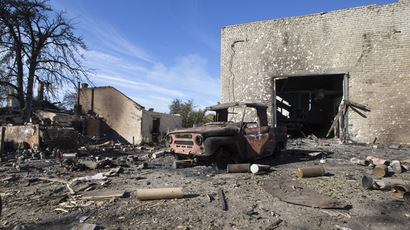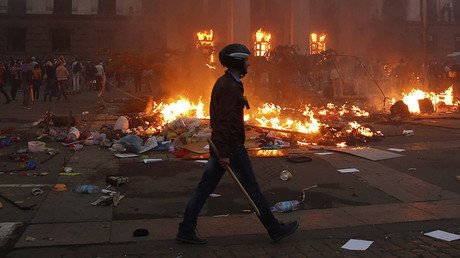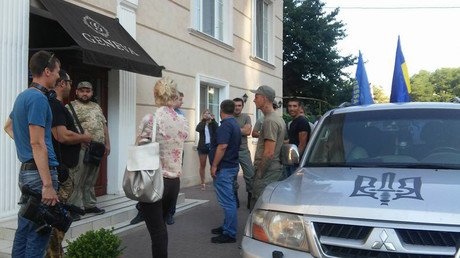Odessa massacre probe drags on 3yrs after over 40 anti-coup activists burnt alive in Ukrainian city
The nearly 50 victims of the May 2014 violence in Odessa, Ukraine – most of whom died in a trade union building after being attacked by pro-Kiev radicals – are remembered across the world 3 years on, while no verdict has been delivered in the case.
On May 2, Odessa marks the anniversary of the tragedy that took the lives of at least 48 people, including seven women, and injured 250 others, in the worst act of violence against civilians in the Ukrainian port city since the massacres of World War II. Despite being widely filmed and live-streamed, the tragedy, including its gruesome aftermath, has become the subject of conspiracies and speculation, while the courts have not found anyone responsible for organizing or participating in the violence.
The Ukrainian authorities have launched a number of criminal cases in connection with what has become known as the new ‘Odessa massacre,’ but court hearings have been postponed on several occasions. In 2015, an investigation into the events was abruptly suspended when the investigation team was disbanded due to a restructuring of the Ukrainian police.
An investigation into the alleged role of the former Odessa police head, who faces charges of negligence and abuse of power, has also stalled.
While no verdict has been delivered in the ever-expanding criminal case, the number of those put on the wanted list continues to grow.
A hunt has been launched for 18 people suspected of organizing and participating in mass disturbances and committing other criminal offences, including murder, the Odessa prosecutor’s office said in April. So far, 26 people have been charged, though their cases have been pending for over two years.
Russia’s permanent OSCE representative, Dmitry Balakin, spoke last week about the reluctance of the Ukrainian authorities to conduct an investigation into the events.
“OSCE’s special monitoring mission reported another disruption in the case of one of the suspects due to pressure from radicals who entered the court room on April 19, where not even one policeman was present,” he said.
More than 3,000 Ukrainian police and soldiers have been deployed to Odessa this week, as the city marks three years since the confrontation between pro- and anti-government activists.
Following the 2014 armed coup in Kiev, people in Odessa gathered in the central Kulikovo Polye square to peacefully protest against what they considered an illegitimate, coup-imposed government, setting up tents and gathering signatures for a referendum calling for the federalization of Ukraine and for the legal recognition of the Russian language in the country.
On May 2, a group of football hooligans and Right Sector radicals (members of a nationalist group, banned in Russia for extremism) attacked the anti-coup activists and set fire to their camp in the central square.
Many people tried to take refuge in a nearby trade union building in an attempt to hide from the radicals, who had the advantage in numbers. The radicals, however, set the building on fire with Molotov cocktails, while at least one of the attackers was filmed shooting at people with a handgun. Some of those who survived the fire were beaten to death with bats on the ground, eyewitnesses claimed.
Numerous videos released online indicate that some of the victims of the Odessa massacre received bullet wounds.
Police did nothing to prevent the bloodshed, a survivor of the massacre told RT. The fire department also did not rush to rescue people, the woman claimed. “When firefighters arrived, it was too late – too many people had already died, even though the closest fire station is 700 meters away from the site,” she claimed, adding that “police was idle.”
The hundreds of individuals who gathered outside the burning building prevented firefighters from getting close to the building for quite some time, another witness – the head of Odessa’s emergency service department, Vladimir Bodelan – claimed.
An official report from Kiev said that 32 people suffocated or died in the fire, 10 fell to their deaths, and another six people died of gunshot wounds. Some independent groups claim the death toll may be much higher than the officially released numbers. Last year, local historian and publicist Aleksey Ivakin, who spent two years investigating the tragedy, claimed that there were as many as 397 victims.
Last week, a demonstration was held in The Hague, commemorating the victims of the Odessa massacre and demanding punishment for those who killed innocent civilians, while also aiming to draw attention to the situation in Ukraine, TASS reported.
Rally in #Dutch capital pays tribute to #Odessa fire victimshttps://t.co/a5KWOfgu04#Hague#Ukraine#nazism#neonazism#fascism#2мая2014pic.twitter.com/iMEHvIvc2T
— FromSevastopol (@FromSevastopol) May 1, 2017
“We do not want Odessa [bloodshed] to be forgotten. Until justice is served in Odessa, until villains are punished, we will keep protesting and drawing attention to what happened in the city,” the event’s organizer, Dmitry Pisarev, told TASS, adding that the recent protest “is yet another attempt to break an information blockade.”















